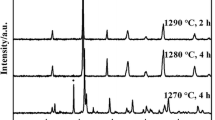Abstract
Composites of strontium titanate ceramic particles dispersed in epoxy resin have been manufactured for nondestructive wireless stress sensing. Magnetic coupling with a hairpin resonator on the surface of the composite was used to detect changes in the effective dielectric properties. The hairpin resonator was excited in the microwave frequency domain at 1–10 GHz, and its resonant frequency detected using a network analyzer based on the absorbed power. The results indicated a shift in the resonant frequency of the hairpin resonator under application of stress due to a change in the dielectric constant of the composite.





Similar content being viewed by others
References
A. von Hippel, R.G. Breckenridge, F.G. Chesley, and L. Tisza, Ind. Eng. Chem. (1946). https://doi.org/10.1021/ie50443a009.
G. Rupprecht and R.O. Bell, Phys. Rev. (1964). https://doi.org/10.1103/PhysRev.135.A748.
G.A. Samara, Phys. Rev. (1966). https://doi.org/10.1103/PhysRev.151.378.
B.D. Silverman, Phys. Rev. (1962). https://doi.org/10.1103/PhysRev.125.1921.
J.H. Haeni, P. Irvin, W. Chang, R. Uecker, P. Reiche, Y.L. Li, S. Choudhury, W. Tian, M.E. Hawley, B. Craigo, A.K. Tagantsev, X.Q. Pan, S.K. Streiffer, L.Q. Chen, S.W. Kirchoefer, J. Levy, and D.G. Schlom, Nature (2004). https://doi.org/10.1038/nature02773.
L.C. Sengupta, S. Stowell, E. Ngo, M.E. Oday, and R. Lancto, Integr. Ferroelectr. (1995). https://doi.org/10.1080/10584589508012302.
W. Rehwald, Solid State Commun. (1977). https://doi.org/10.1016/0038-1098(77)90841-9.
T. Hu, J. Juuti, H. Jantunen, and T. Vilkman, J. Eur. Ceram. Soc. (2007). https://doi.org/10.1016/j.jeurceramsoc.2007.02.082.
Y. Kobayashi, T. Tanase, T. Tabata, T. Miwa, and M. Konno, J. Eur. Ceram. Soc. (2008). https://doi.org/10.1016/j.jeurceramsoc.2007.05.007.
N. Jayasundere and B.V. Smith, J. Appl. Phys. (1993). https://doi.org/10.1063/1.354057.
R.L. Stenzel, Rev. Sci. Instrum. (1976). https://doi.org/10.1063/1.1134697.
Y. Rao, J. Qu, T. Marinis, and C.P. Wong, I.E.E.E. Trans Compon. Packag. Technol. (2000). https://doi.org/10.1109/6144.888853.
A. Sihvola, Electromagnetic Mixing Formulas and Applications (London: The Institute of Electrical Engineers, 1999).
R.B. Piejak, V.A. Godyak, R. Garner, B.M. Alexandrovich, and N. Sternberg, J. Appl. Phys. (2004). https://doi.org/10.1063/1.1652247.
S.K. Karkari, C. Gaman, A.R. Ellingboe, I. Swindells, and J.W. Bradley, Meas. Sci. Technol. (2007). https://doi.org/10.1088/0957-0233/18/8/041.
W.J. Staszewski, W.J. Boller, and G.R. Tomlinson, Health Monit. Aerosp. Struct. (2004). https://doi.org/10.1002/0470092866.
W.J. Staszewski, S. Mahzan, and R. Traynor, Compos. Sci. Technol. (2009). https://doi.org/10.1016/j.compscitech.2008.09.034.
F. Xiang, H. Wang, and X. Yao, J. Eur. Ceram. Soc. (2007). https://doi.org/10.1016/j.jeurceramsoc.2006.11.034.
S.D. Cho, S.Y. Lee, J.G. Hyun, and K.W. Paik, J. Mater. Sci. Mater. Electron. (2005). https://doi.org/10.1007/s10854-005-6454-3.
G.A. Samara, Ferroelectrics (1971). https://doi.org/10.1080/00150197108234102.
V. Petrovsky, A. Manohar, and F. Dogan, J. Appl. Phys. (2006). https://doi.org/10.1063/1.2206411.
G.S. Gogna and S.K. Karkari, Appl. Phys. Express (2014). https://doi.org/10.7567/APEX.7.096101.
C.P. Wong and R.S. Bollampally, J. Appl. Polym. Sci. (1999). https://doi.org/10.1002/(SICI)1097-4628(19991227)74:14%3C3396::AID-APP13%3E3.0.CO;2-3
Acknowledgements
The authors acknowledge assistance from Dr. Tyler Tallman’s research group at Purdue University for preparing composite samples.
Author information
Authors and Affiliations
Corresponding author
Rights and permissions
About this article
Cite this article
Dhiman, A., Sharma, A., Shashurin, A. et al. Strontium Titanate Composites for Microwave-Based Stress Sensing. JOM 70, 1811–1815 (2018). https://doi.org/10.1007/s11837-018-2973-2
Received:
Accepted:
Published:
Issue Date:
DOI: https://doi.org/10.1007/s11837-018-2973-2




